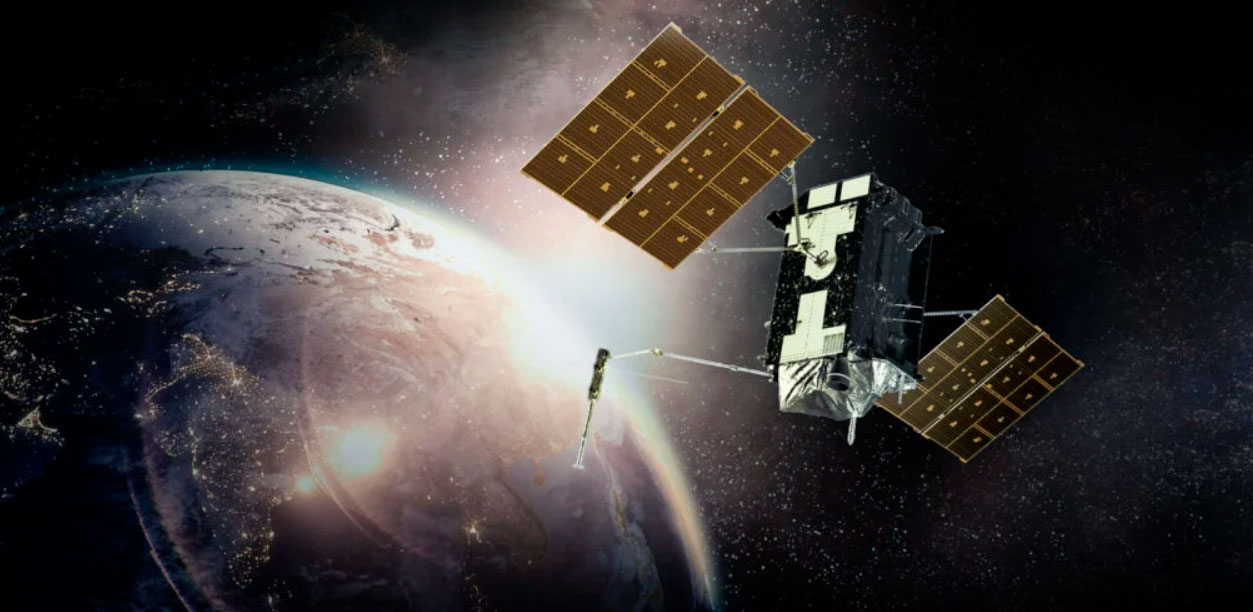Preparándose para el día en que las capacidades de posicionamiento, navegación y sincronización (PNT) de Estados Unidos podrían estar bajo amenaza en una confrontación con otra gran potencia militar, el Comando de Sistemas Espaciales (SSC) de la Fuerza Espacial (USSF, anteriormente el Centro de Sistemas Espaciales y de Misiles) otorgó un contrato de $ 228 millones en abril a Raytheon Intelligence & Space (RI & S) para el desarrollo del Sistema de Control Operacional de Próxima Generación (GPS) del Sistema de Posicionamiento Global (GPS) Follow-On (OCX 3F).
Preparing for the day when America’s positioning, navigation, and timing (PNT) capabilities could be under threat in a Great Power competition, U.S. Space Force’s (USSF) Space Systems Command (SSC, formerly the Space and Missile Systems Center) awarded a $228 million contract in April to Raytheon Intelligence & Space (RI&S) for the Global Positioning System (GPS) Next Generation Operational Control System (OCX) Follow-On (OCX 3F).
The GPS OCX is the enhanced ground-control segment of Space Force’s modernization of the U.S. GPS system, and is one of three key segments in the satellite-based radio navigation system that provides accurate PNT for military and civil users worldwide.
They are: (1) the Space Segment, which is the constellation of Boeing and Lockheed Martin-built satellites on orbit; (2) the Control Segment, the ground-based hardware/software responsible for tracking, monitoring, and updating the satellites; and (3) the User Segment, which is the GPS receiver equipment that receives signals from satellites and provides a user’s exact position, velocity and time.
The OCX 3F program is part of Space Force’s GPS Enterprise Modernization effort to upgrade OCX Blocks 1 & 2 systems to utilize the enhanced capabilities of the new GPS IIIF space vehicles being developed by Lockheed Martin. The improved ground control system is planned for delivery in 2022.
The software upgrade will represent a major evolution in capabilities for the GPS enterprise. In addition to supporting the latest Department of Defense standards and practices for cybersecurity, it also supports a number of advanced features over the legacy GPS ground segment.
These new features include an enhanced and expanded monitor station network for improved cybersecurity and improved anti-jam capability, enhanced operational capability to control the modernized military signals, support of GPS III boosted-Earth-coverage Military code (M-Code), and the monitoring of new Galileo-compatible and safety-of-life signals such as those needed for aviation. (Like GPS, Galileo is also a global navigation satellite system and is operated by the European Space Agency for the European Union.)
To discuss these new systems and capabilities, we interviewed Barbara Baker, Senior Materiel Leader, C2 Systems Division, Production Corps, USSF SSC, Los Angeles AFB, California, and Sandy Brown, vice president, Strategic Systems, Space and C2 Systems, Raytheon Intelligence & Space (RI&S).
Breaking Defense: Describe the present status of our GPS satellites and their ground control stations today.

Baker: Due to the delays with OCX, the United States Space Force delivered two software upgrades to the current Operational Control Segment (OCS)—Contingency Operations (COps) and M-Code Early Use (MCEU). COps allows the current OCS ground system to command and control the new GPS III satellites and MCEU allows OCS to task, upload, and monitor M-Code capabilities on the constellation.
Following the operational acceptance of the MCEU control-system hardware and software upgrade to the current OCS Architecture Evolution Plan (AEP) in November 2020, M-Code signals are currently available on all 23 GPS IIR-M, IIF and III space vehicles. The Space Force added GPS III SV05 to the M-Code-capable constellation following the successful June 17, 2021 launch and pending subsequent checkout, bringing the total up to 24 M-Code-capable space vehicles for 24/7 coverage of this important military enhancement. The MCEU upgrade to the current OCS ground system will also enable the Space Force to make an M-Code Early Use Declaration later this year.
Military GPS User Equipment (MGUE) Increment 1’s Ground-Based User Equipment has completed development and received formal Program Executive Officer certification for two lead platforms to proceed with the service’s Field User Evaluations. The U.S. Marine Corps and U.S. Army will have a consolidated field test of the MGUE Increment 1 leveraging the Marine Corps Joint Light Tactical Vehicle (JLTV) later this year. In addition, the DoD, through its contracts with the MGUE developers, will procure over one million Digital Application-Specific Integrated Circuits (Digital ASICs) for MGUE Increment 1, enabling the services to begin volume Increment 1 purchases.
Breaking Defense: OCX modernization is primarily a software program. Tell me about your software-development process.

Brown: OCX is built on a flexible service-oriented architecture that includes a robust infrastructure needed to support future capabilities such as those being filled with the GPS IIIF satellites. The OCX 3F program builds upon our GPS OCX Block One and Two software baseline, and it maximizes software environment reuse. We are fully compliant with the DoD enterprise DevSecOps reference design with cybersecurity being built into the solution.
So in addition to the rapid development with DevSecOps, we’re fully agile. We’re going to use the scaled agile framework to deliver capabilities faster and offer a more responsive and efficient design environment as we work shoulder to shoulder with our customer to deliver these capabilities faster.
Breaking Defense: Why did the ground control system need to be modernized? Modernized to do what?
Baker: The Air Force has continually improved GPS since the launch of the first GPS Block I satellite in 1978, and this ongoing modernization has provided new signals, greater accuracy, and increased robustness for civil and military users. After the first 10 GPS III satellites are launched over the next few years, up to 22 GPS III Follow-on (GPS IIIF) satellites will provide yet another step increase in GPS capabilities.
GPS III broadcasts all the signals provided by previous GPS satellite blocks, and these signals have already been verified to maintain backwards compatibility, meaning current GPS receivers will continue to process them as normal. On-orbit tests have verified that the new satellite’s signal performance meets or exceeds all requirements.
GPS III satellites provide significant new capabilities:
- The new L1C signal was designed with international participation to be highly interoperable and compatible with other systems’ open-service signals. Its signal structure provides greater robustness, higher accuracy in multipath, and features for a range of applications from low-cost consumer devices to high-end professional devices. L1C also delivers greater than 40 percent more power than the Coarse/Acquisition signal used around the world for decades.
- GPS III M-Code signals deliver higher power to combat jamming in contested environments—more than seven times the power of the P(Y) signal used for military operations today, and more than three times the power of M-Code signals broadcast from Block II satellites.
- All GPS III signals are broadcast with greater accuracy due to enhanced atomic clocks specified to be three times more accurate than previous GPS atomic clocks.
- The GPS III satellite architecture is designed to incorporate new capabilities in the follow-on GPS IIIF program.
GPS IIIF satellites will build on GPS III capabilities by adding Regional Military Protection capability and three secondary payloads. Regional Military Protection concentrates even higher M-Code signal power in a targeted region—allowing receivers to operate more than 10 times closer to a jammer than with the military signals operational today.
One new secondary payload is a Search and Rescue payload to geo-locate emergency transponders and provide coordinates for rapid assistance to distressed users. Another new payload is a Laser Retroreflector Array that enables independent ranging and ephemeris verification from surveyed ground sites worldwide. The third payload is the redesigned Nuclear Detonation Detection System.
Brown: The new capabilities will revolutionize GPS command and control from the point of view of availability, reliability, accuracy and cybersecurity. Modernization will enhance mission management and mission-data processing to shift the focus of operations from satellite command and control to basic, user-oriented effects-based operation. The key capabilities for our warfighter were providing pathfinding information to protect the system against cyber attack.
We’ll also see improved availability of military accuracy, especially in jammed environments. We also are increasing position accuracy and enhancing the system integrity to ensure that our warfighters have the most robust information to make decisions when they matter the most.
Breaking Defense: OCX 3F upgrades OCX Blocks 1 & 2 system to utilize the enhanced capabilities of the new GPS IIIF space vehicles being developed by Lockheed Martin. Please provide some details.
Brown: RI&S is working very closely with the United States Space Force to provide GPS OCX on their timeline. Our goal is to make the final delivery of Block 1 in 2022. As far as current progress all 17 GPS monitor stations are now deployed worldwide, and the system’s high-fidelity GPS system simulator was recently accredited. The Global Information Grid Automated Information System Element and the Legacy Ground Antenna Element have been recently formally qualified with the United States Space Force.
There are no anticipated hardware upgrades for GPS OCX with this upgrade. 3F is primarily a software upgrade to the Block 1 baseline to support the 22 future IIIF satellites. The software has to be upgraded to support the additional capabilities the IIIF satellites offer over GPS II and GPS III satellites.
IIIF satellites have a few new capabilities worth highlighting. One is that the GPS IIIF satellites support new and modified payloads, such as Search and Rescue.
Baker: The GPS OCX 3F is not a standalone system. It is part of the current GPS Enterprise Modernization effort. The OCX 3F program, an upgrade of OCX Blocks 1 & 2 system, is essential to the first GPS IIIF satellite launch in 2026. The overall acquisition strategy is to update the existing OCX software for compatibility with new GPS IIIF features while maintaining backwards compatibility for the existing constellation.
GPS OCX 3F will support launch, command and control, and monitoring of GPS IIIF and legacy GPS satellites. OCX 3F will upgrade OCX software baseline to enable new capabilities in support of GPS IIIF satellites. GPS IIIF satellites introduce Regional Military Protection (RMP), which provides time-sensitive, regional high-powered military signal to strengthen U.S. and allied forces’ GPS resiliency in contested environments, as well as the ability to rapidly reconfigure GPS IIIF satellites to create time-critical warfighter effects.
Breaking Defense: GPS plays a vital role in a variety of industries, all of which demand better cybersecurity for the system. Talk about OCX and cyber.
Brown: GPS is incredibly critical to our national security and our economy. The banking industry relies on GPS to timestamp transactions, minimizing fraud and ensuring precisely timed banking. Construction and farming industries are also dependent on GPS for centimeter-level surveying results that are available instantly, saving time and money and farming practices are improved through enhanced field navigation using GPS. Of course, supporting U.S. forces is a key component of the system and I’m pleased to add that GPS OCX offers the highest level of cybersecurity of any Department of Defense ground space system.
So with the RI&S GPS OCX solution, we provide that modern cyber-secure infrastructure, improved accuracy, the globally deployed modernized receivers with anti-jam capabilities and improved availability, again in that difficult terrain. The system is also capable of monitoring the health and status of satellites.
Breaking Defense: What are the physical aspects of OCX?
Baker: OCX Block 0, or the Launch and Checkout System, is already fielded and allows a combined Space Force, Lockheed Martin, and Raytheon team to conduct launch and checkout operations from the Lockheed Martin facility at Waterton, Colorado. OCX Blocks 1 and 2 include a Master Control Station at Schriever AFB, Colorado, and an Alternate Master Control Station at Vandenberg AFB, California, along with 17 worldwide monitoring stations and 4 worldwide GPS-specific ground antennas. All Blocks are also able to interface with the Space Force’s Satellite Control Network (SCN).
Breaking Defense: How did you track and review Raytheon’s work to ensure OCX was properly upgraded? How is it performing?
Baker: The United States Space Force and Raytheon have made significant progress since OCX’s Nunn-McCurdy Recertification in 2016. The OCX Blocks 1 & 2 program continues through integration and test, and worldwide monitoring station deployments in order to transition into operations.
The OCX Blocks 1 & 2 program is an adaptive architecture designed to evolve to combat emerging threats. OCX 3F program takes advantage of this architecture by modifying only 10 percent of the legacy system’s software to achieve all ground-control requirements for supporting GPS IIIF. Additionally, OCX 3F will incorporate early and frequent testing and integration touchpoints with the GPS IIIF space segment to support enterprise alignment. The program office is applying lessons learned and leveraging existing processes from the legacy program to aid in program execution to inform the contract and incentive structures, software development approach, data and metrics, and contractor staffing.
Part of OCX Blocks 1 & 2 Nunn-McCurdy restructuring included the modernization of the OCX software factory. This modernization provided both the government and Raytheon with real-time access to developmental data and metrics. This enables data-driven decisions and ability to track progress at a much more detailed level. OCX 3F continues to refine and mature the software development efficiencies that benefitted OCX Block 1 and 2 development.
Breaking Defense: Describe the relationship between Space Force’s SSC and RI&S.
Baker: The Space Force OCX program team is located with Space Systems Command at Los Angeles AFB in El Segundo, California and has an in-plant team with Raytheon in Aurora, Colorado as well to promote collaboration. Both teams have real-time access to a wide range of data and metrics. This enables data-driven decisions and ability to track progress at a very detailed level.
Brown: We do have a unique relationship. Space Force personnel are assigned and embedded within the Raytheon development teams to ensure alignment of SSC goals and requirements to our RI&S execution. It’s certainly a one-team approach with continuous collaboration and daily engagements. Our program’s success is highly dependent upon leveraging the scaled-agile framework, which requires this level of collaboration amongst the team.
In the area of training, we are responsible under the GPS OCX contract for training our government counterparts prior to system delivery. We will ensure that they understand the operations upon final delivery. Again, they are an embedded part of our team. So they’re also with us as we’re writing the processes and procedures, and will continuously check them out with us up until delivery. Obviously, we’ll have a formal training program at the point in time that we do make delivery onsite. Having SSC embedded helps with the product and in making sure that the final delivery is successful from a training perspective.
Under the OCX contract, we also own Block 0, which is the launch and control system. That group is already embedded at Schriever and they are responsible for controlling the launch, early orbit operations, and on-orbit checkouts of all the GPS III satellites. They are basically our operations counterparts, if you will, to OCX. As we look to operationalize the system, that group will grow to include ongoing operator trainer engagement, as well as the maintenance of the hardware. Our software factory in Aurora will be responsible for making any updates and responding to any software trouble tickets, so that will be an ongoing software factory deliverable, as well.
Fuente: https://breakingdefense.com


